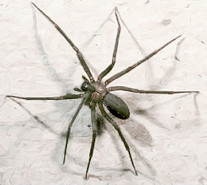Brown recluse spider
Species of spider
The brown recluse spider (Loxosceles reclusa) is a species of spider in the family Sicariidae. It is native to the United States, particularly in the Midwest and South. The brown recluse is known for its necrotic venom, which can cause significant medical issues in humans.
Description[edit | edit source]
The brown recluse spider is typically light to medium brown, with a characteristic dark violin-shaped marking on its back. The spider's body length ranges from 6 to 20 millimeters, but it can appear larger due to its long legs. Unlike most spiders, the brown recluse has six eyes arranged in pairs (dyads) with one median pair and two lateral pairs.
Habitat[edit | edit source]
Brown recluse spiders prefer warm, dry environments and are often found in human dwellings. They commonly inhabit basements, attics, and garages, as well as outdoor areas such as woodpiles and sheds. The spider is nocturnal and tends to avoid human contact, hence the name "recluse."
Behavior[edit | edit source]
Brown recluse spiders are not aggressive and typically bite only when threatened or disturbed. They are known for their reclusive behavior, often hiding in dark, undisturbed areas. The spider's diet consists mainly of small insects and other arthropods.
Venom[edit | edit source]
The venom of the brown recluse spider contains a complex mixture of enzymes, including sphingomyelinase D, which can cause severe tissue damage. Bites from the brown recluse can result in necrosis, leading to open sores and, in severe cases, systemic symptoms such as fever, chills, and nausea. Medical attention is often required for bites, especially if significant tissue damage occurs.
Medical Significance[edit | edit source]
Brown recluse spider bites can be medically significant, particularly in cases where necrosis develops. Treatment may involve wound care, pain management, and, in some cases, surgical intervention. It is important to seek medical attention if a brown recluse bite is suspected.
Prevention[edit | edit source]
Preventing brown recluse spider bites involves reducing the likelihood of encountering the spider. This can be achieved by keeping homes clean and clutter-free, sealing cracks and crevices, and using insecticides in areas where spiders are likely to inhabit. Wearing gloves and long sleeves when handling items stored in basements or attics can also reduce the risk of bites.
See also[edit | edit source]
References[edit | edit source]
Search WikiMD
Ad.Tired of being Overweight? Try W8MD's physician weight loss program.
Semaglutide (Ozempic / Wegovy and Tirzepatide (Mounjaro / Zepbound) available.
Advertise on WikiMD
|
WikiMD's Wellness Encyclopedia |
| Let Food Be Thy Medicine Medicine Thy Food - Hippocrates |
Translate this page: - East Asian
中文,
日本,
한국어,
South Asian
हिन्दी,
தமிழ்,
తెలుగు,
Urdu,
ಕನ್ನಡ,
Southeast Asian
Indonesian,
Vietnamese,
Thai,
မြန်မာဘာသာ,
বাংলা
European
español,
Deutsch,
français,
Greek,
português do Brasil,
polski,
română,
русский,
Nederlands,
norsk,
svenska,
suomi,
Italian
Middle Eastern & African
عربى,
Turkish,
Persian,
Hebrew,
Afrikaans,
isiZulu,
Kiswahili,
Other
Bulgarian,
Hungarian,
Czech,
Swedish,
മലയാളം,
मराठी,
ਪੰਜਾਬੀ,
ગુજરાતી,
Portuguese,
Ukrainian
Medical Disclaimer: WikiMD is not a substitute for professional medical advice. The information on WikiMD is provided as an information resource only, may be incorrect, outdated or misleading, and is not to be used or relied on for any diagnostic or treatment purposes. Please consult your health care provider before making any healthcare decisions or for guidance about a specific medical condition. WikiMD expressly disclaims responsibility, and shall have no liability, for any damages, loss, injury, or liability whatsoever suffered as a result of your reliance on the information contained in this site. By visiting this site you agree to the foregoing terms and conditions, which may from time to time be changed or supplemented by WikiMD. If you do not agree to the foregoing terms and conditions, you should not enter or use this site. See full disclaimer.
Credits:Most images are courtesy of Wikimedia commons, and templates, categories Wikipedia, licensed under CC BY SA or similar.
Contributors: Prab R. Tumpati, MD



